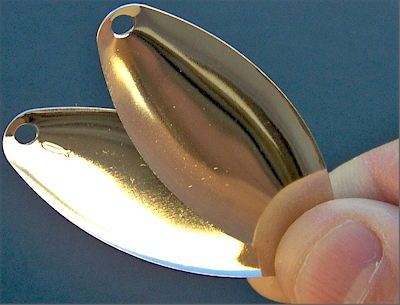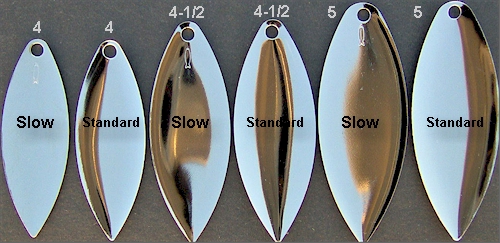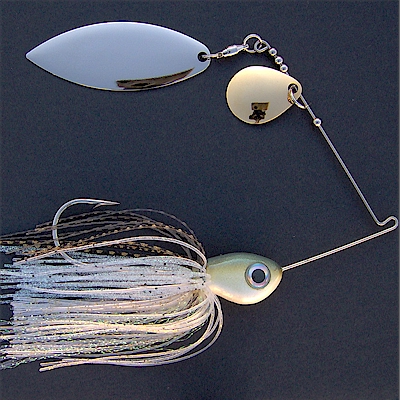-
 Slow Willow Spinnerbait Blades
Slow Willow Spinnerbait Blades
Great article on www.bassdozer.com
Slow Willow Spinnerbait Blades
There are numerous Willow blades on the market. They all look the same but like snowflakes, no two are exactly alike. Slight differences in shape, width, length, material and cup or curvature make different Willows behave differently. It takes a knowing eye to see the subtle behavior differences when Willows move through the water, but it is there. The Slow Willow is one that's so different it deserves special mention. Slow Willow blades are the same length, width and exact oval shape as standard willow blades. All the dimensions of standard Willow and Slow Willow blades are identical - except the Slow Willow has much less concave/convex curvature or cup than the standard Willow. The Slow Willow has a shallow cup and looks flatter compared to the standard Willow.

Slow Willow (left) and standard Willow (right) are the same size, except for cup depth.
This difference, the shallower degree of cup, makes the Slow Willow start spinning at slower speeds than a standard Willow. When you start to retrieve a standard Willow at a slow speed, you may have to jerk the bait and reel it faster at first in order to get the blade spinning. On the other hand, with the Slow Willow blade, there's not as much of a start-up problem at the beginning of the retrieve. You get smoother, easier, better starts with the Slow Willows during those first few important seconds of the retrieve when aggressive, active fish will rush over eager to strike if the spinnerbait looks appealing.
Likewise at the end of a retrieve, as a slow-rolled spinnerbait gets closer to the boat, a standard Willow blade can stop turning during the last leg of the retrieve. If you are tuned in to the blade's vibration up the line, it's pretty apparent when you feel it just go dead and stop rotating as it nears the boat. Unfortunately that's a critical strike point since following fish often react right when a slow-rolled spinnerbait starts rising vertically toward the boat - but that's just when a standard Willow tends to stop turning too. The Slow Willow will continue to spin longer at the end of the retrieve and it starts turning earlier at the start of a retrieve. A few more seconds better performance may not seem like a lot, but those are two high percentage strike moments - the very beginning, and with slow-rolling the very end of a retrieve when the blades are hesitant and having trouble turning.
So at the beginning and end of a retrieve, the Slow Willow spins a little better. During the middle of a retrieve, it can be fished a little slower than a standard Willow.
The Slow Willow blade also spins at a greater degree of cant or skew from the wire arm axis. In other words, whereas the standard Willow spins quite tightly, the Slow Willow spins in a wider arc. This makes a Slow Willow appear a little bigger, more visible and flashier than a standard Willow. Also more torque and water drag result, which lets you fish the Slow Willow slower than a standard Willow.
So that's why I say no two Willow blades work the same. We can see here where only one property - the degree of cup - is different, it causes a dramatic difference in how the Slow Willow fishes compared to the standard Willow.
Here are a few (not all) tips for using Slow Willow blades:
- First and foremost, think slow-rolling and fishing slowly with the Slow Willow.
- Enhanced lift at high speed. On the other hand, since the Slow Willow has more torque, therefore more lift and rise than a standard Willow, it can be used to help keep a speedily retrieved spinnerbait near the surface. That sounds like a contradiction, but the torque that lets you use the Slow Willow more slowly is the same torque that lifts it higher on a fast retrieve.
- Size #4, #4-1/2 and #5 are the sizes you see on over 90% of all bass spinnerbaits that have willow blades. Actually, #4 and #5 are by far most common.
- Size #4 tends to be used more often on 1/4, 3/8 and some 1/2 ounce spinnerbaits.
- Sizes #4-1/2 and #5 tend to be used most often on 1/2 to 1 ounce spinnerbaits.
- On double willow spinnerbaits, occasionally (and more often with a pair of #4s), both blades may be the same size. But 90% of the time with double willows, the front blade tends to be a half or full size smaller than the back blade.
- A small, light Colorado blade such as a #2 Colorado makes a great front runner ahead of a Slow Willow.
Here is a comparison photo and size chart for Slow Willow blades compared to standard Willow blades"
StyleSizeLengthWidthSlow Willow#41.872".640"Slow Willow#4-1/22.062".740"Slow Willow#52.260".836"
:
Slow Willows are the same size and shape as standard Willows, except for the cup.
 This spinnerbait has a Slow Willow blade. You can really slow this spinnerbait down to a crawl for deep slow-rolling. At the very start of a cast, this blade starts to turn more easily. During the middle or main part of the retrieve, it keeps turning at slower retrieve speeds than most other Willow blades. At the end of the retrieve, most other slow-rolled Willows stall and conk out. When a slow-rolled spinnerbait gets directly under the boat, the angle of line pull changes, and the spinnerbait starts to face up and rise up. That angle of change is a high percentage strike point that occurs the instant when the bait is almost directly under the boat and starts to come up. Many bass are content for some reason to just follow along behind slow-rolled spinnerbaits without making any effort to strike them. They'll often follow slow-rolled spinnerbaits far from the cover where the bass was holding, just trailing behind the spinnerbait - until the bait changes direction directly under the boat - and BAM! Unfortunately, many Willow blades give up and just stop turning close to the boat. But the blade used on the spinnerbait you see here will tend to still rotate at the key strike point right under the boat.
This spinnerbait has a Slow Willow blade. You can really slow this spinnerbait down to a crawl for deep slow-rolling. At the very start of a cast, this blade starts to turn more easily. During the middle or main part of the retrieve, it keeps turning at slower retrieve speeds than most other Willow blades. At the end of the retrieve, most other slow-rolled Willows stall and conk out. When a slow-rolled spinnerbait gets directly under the boat, the angle of line pull changes, and the spinnerbait starts to face up and rise up. That angle of change is a high percentage strike point that occurs the instant when the bait is almost directly under the boat and starts to come up. Many bass are content for some reason to just follow along behind slow-rolled spinnerbaits without making any effort to strike them. They'll often follow slow-rolled spinnerbaits far from the cover where the bass was holding, just trailing behind the spinnerbait - until the bait changes direction directly under the boat - and BAM! Unfortunately, many Willow blades give up and just stop turning close to the boat. But the blade used on the spinnerbait you see here will tend to still rotate at the key strike point right under the boat.
http://www.bassdozer.com/articles/sp...t-blades.shtml
 Posting Permissions
Posting Permissions
- You may not post new threads
- You may not post replies
- You may not post attachments
- You may not edit your posts
-
Forum Rules
This spinnerbait has a Slow Willow blade. You can really slow this spinnerbait down to a crawl for deep slow-rolling. At the very start of a cast, this blade starts to turn more easily. During the middle or main part of the retrieve, it keeps turning at slower retrieve speeds than most other Willow blades. At the end of the retrieve, most other slow-rolled Willows stall and conk out. When a slow-rolled spinnerbait gets directly under the boat, the angle of line pull changes, and the spinnerbait starts to face up and rise up. That angle of change is a high percentage strike point that occurs the instant when the bait is almost directly under the boat and starts to come up. Many bass are content for some reason to just follow along behind slow-rolled spinnerbaits without making any effort to strike them. They'll often follow slow-rolled spinnerbaits far from the cover where the bass was holding, just trailing behind the spinnerbait - until the bait changes direction directly under the boat - and BAM! Unfortunately, many Willow blades give up and just stop turning close to the boat. But the blade used on the spinnerbait you see here will tend to still rotate at the key strike point right under the boat.





 Reply With Quote
Reply With Quote